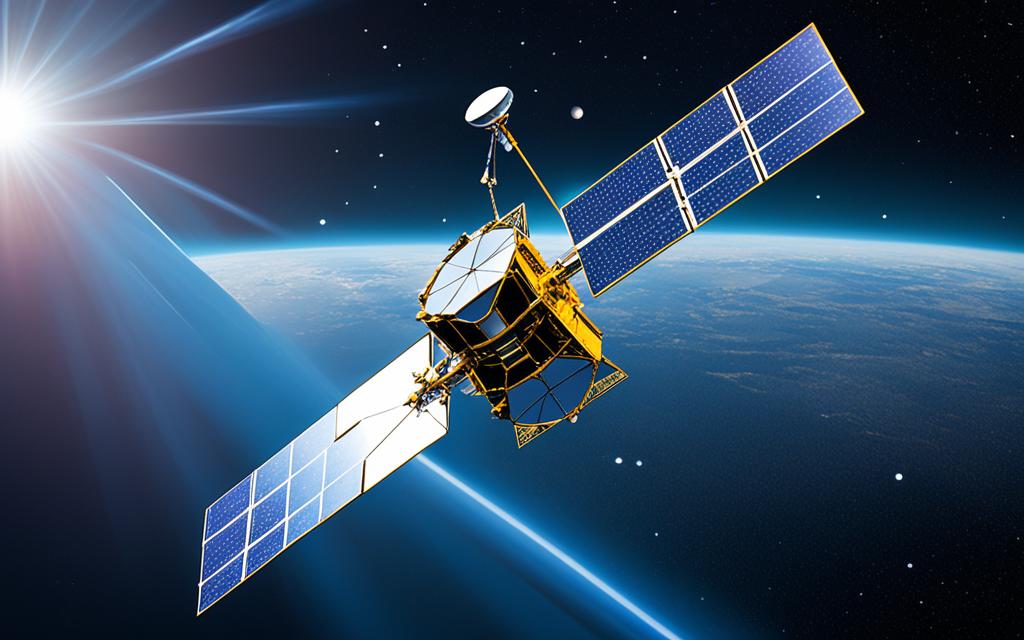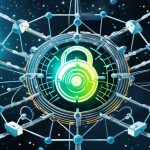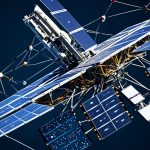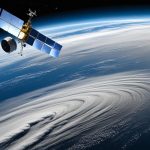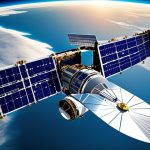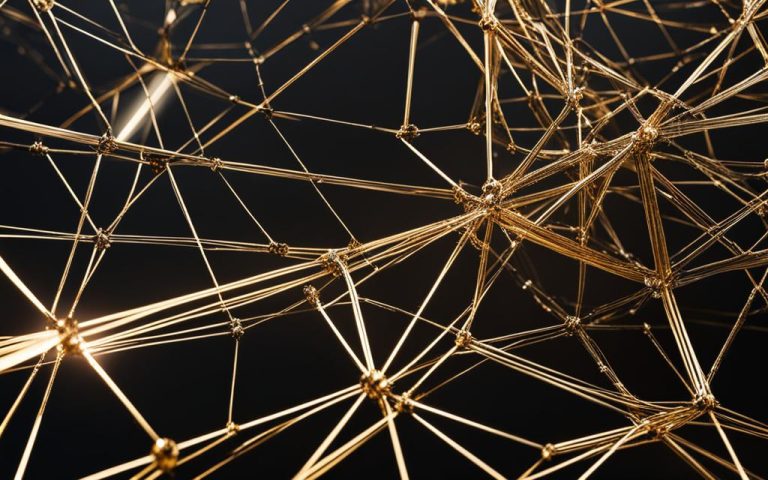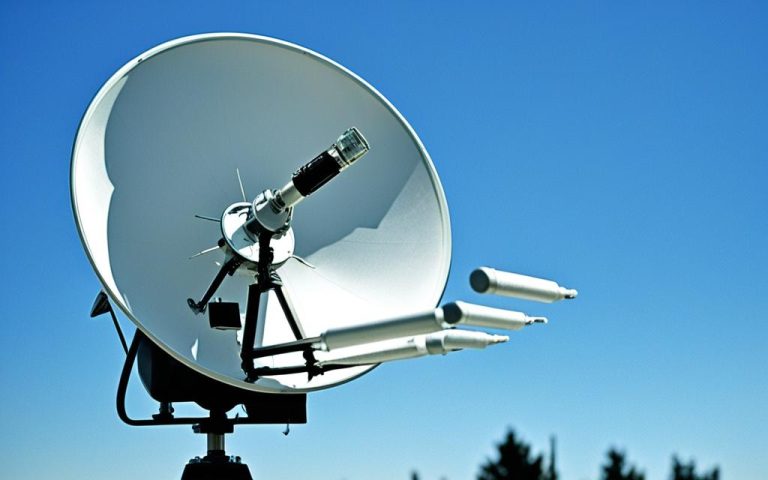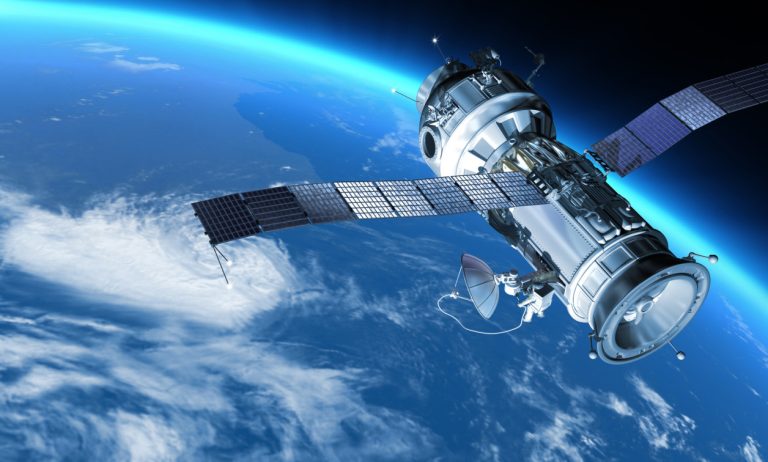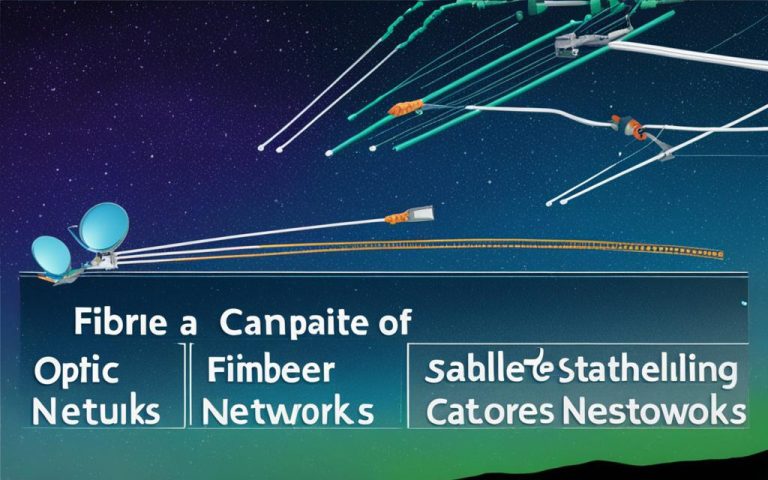Quantum communication satellites are at the forefront of revolutionizing secure communication in space. These advanced satellites utilize the principles of quantum mechanics to establish secure space networks, ensuring the protection of data transmission in an increasingly interconnected world. With their potential to provide unbreakable encryption and immunity to quantum computer threats, quantum communication satellites are shaping the future of secure communication.
As the demand for secure data transmission continues to grow, quantum-secured communication becomes paramount. Traditional key exchange algorithms are vulnerable to quantum computers, making quantum-secured communications indispensable for enterprises and government agencies. Quantum-secured communication, based on Quantum Key Distribution (QKD) methodology, offers unconditional security by establishing separate quantum and classical channels for key distribution and data transmission.
The Importance of Quantum-Secured Communications
Traditional key exchange algorithms used for data encryption are vulnerable to quantum computers. Quantum-secured communications, based on the Quantum Key Distribution (QKD) methodology, provide unconditional security of critical data using quantum-resistant communication channels. This approach establishes separate quantum and classical channels for key distribution and data transmission, ensuring secure communication even in the presence of quantum computers. Mitigating the risk of data breaches and ensuring secure communication channels is of utmost importance for enterprises and government agencies.
Quantum-secured communications offer a significant advancement in data security by leveraging the principles of quantum mechanics. Unlike traditional encryption methods, which rely on complex mathematical algorithms vulnerable to quantum computational attacks, quantum-secured communications provide a level of security that cannot be compromised by quantum computers.
Quantum Key Distribution (QKD) is the foundation of quantum-secured communications. It enables the secure exchange of encryption keys between two parties, ensuring that data remains confidential and cannot be intercepted or tampered with during transmission.
The fundamental principle behind QKD is the use of quantum states, such as polarized photons, to encode information. Any attempt to intercept the quantum states causes a disturbance, thus alerting the communicating parties to the presence of an eavesdropper. This feature, known as the “no-cloning theorem,” guarantees the security of the shared encryption keys.
The Key Benefits of Quantum-Secured Communications
- Unbreakable Encryption: Quantum-secured communications provide the highest level of data security, as the encryption keys are generated using quantum principles, making them virtually unbreakable.
- Quantum-Resistance: Traditional encryption methods are susceptible to attacks from quantum computers. Quantum-secured communications utilize quantum-resistant communication channels, ensuring long-term data security in a post-quantum world.
- Secure Key Distribution: QKD ensures secure key distribution, allowing for the exchange of encryption keys without the risk of interception or compromise.
- Future-Proofing Data Security: By embracing quantum-secured communications, organizations can protect sensitive data against emerging threats posed by quantum computers.
To illustrate the importance of quantum-secured communications, consider the following scenario: A government agency transmitting classified information over a conventional communication system is at risk of unauthorized access and data breaches. However, by implementing quantum-secured communications, the agency can ensure that the information remains confidential and inaccessible to malicious actors, protecting national security and sensitive data.
“Quantum-secured communications provide unconditional security and offer a breakthrough solution for safeguarding data transmission in the era of quantum computing.” – Dr. Elizabeth Kim, Quantum Communications Expert
By embracing quantum-secured communications, organizations can safeguard their data, protect their networks, and maintain the confidentiality and integrity of sensitive information. Governments, financial institutions, and healthcare organizations are investing in quantum technologies to secure their data and ensure the privacy of their communications.
| Benefits of Quantum-Secured Communications | Traditional Encryption | Quantum-Secured Communications |
|---|---|---|
| Level of Security | Moderate | High |
| Vulnerability to Quantum Computers | Vulnerable | Resistant |
| Key Distribution | Risk of Interception | Secure |
| Post-Quantum Security | At Risk | Future-Proof |
As seen in the table above, quantum-secured communications offer a higher level of security compared to traditional encryption methods and are resistant to quantum computational attacks. The secure key distribution and future-proof nature of quantum-secured communications make them an essential tool for protecting sensitive data in the digital age.
Progress in Quantum-Secured Communications
Significant progress has been made in the development of quantum-secured communications, specifically in the field of quantum-secured optical channels. Ciena, a leading optical communications company, has successfully showcased 800Gbps quantum-secured communications for short-distance applications. This breakthrough demonstrates the potential of quantum communications in achieving high-speed and secure data transmission.
However, the establishment of long-distance quantum communications poses technological challenges. To address this, two approaches are being explored: terrestrial quantum repeaters and satellite quantum communication.
Terrestrial Quantum Repeaters: This approach involves the installation of quantum repeaters along long-distance fiber optic links. Quantum repeaters play a vital role in extending the reach of quantum communication, as they help overcome the limitations of optical fiber attenuation. By amplifying and regenerating the quantum signals, quantum repeaters enable the transmission of quantum information over longer distances, ensuring the viability of quantum-secured channels.
Satellite Quantum Communication: Another promising avenue in quantum communication is the utilization of satellites to establish quantum channels and generate quantum keys between ground stations. Satellite quantum communication offers several advantages, including the ability to establish long-distance connections without being limited by the Earth’s curvature or the signal loss in optical fibers. Successful demonstrations of long-distance communication have already been achieved, such as the collaboration between Beijing and Vienna.
| Approach | Advantages | Challenges |
|---|---|---|
| Terrestrial Quantum Repeaters | – Leverage existing fiber optic infrastructure – Extend reach of quantum communication |
– Limited by optical fiber attenuation – Require precise synchronization – Technological complexity |
| Satellite Quantum Communication | – Overcome limitations of Earth’s curvature – Extend reach of quantum communication – Potential for global coverage |
– Expensive satellite deployment – Atmospheric interference – Complex quantum key distribution |
By exploring both terrestrial quantum repeaters and satellite quantum communication, researchers and engineers are paving the way for the establishment of quantum-secured communications on a global scale. These advancements offer great potential for enhancing data security and transforming how we communicate in an increasingly interconnected world.
The QEYSSAT Project and Ciena’s Role
The Quantum EncrYption and Science Satellite (QEYSSAT) project, owned and operated by the Canadian Space Agency (CSA), is at the forefront of exploring the potential of satellite quantum communication. At the heart of this groundbreaking initiative is Ciena, a key participant leveraging its expertise in quantum-secured optical channels.
Ciena’s engagement in the QEYSSAT project is focused on establishing a secure quantum-secured optical channel between Quantum Ground Stations (QGS). This channel serves as the foundation for protecting critical data transmission over long distances, laying the groundwork for secure space networks.
To facilitate quantum-secured communication between QGS, Ciena’s Waveserver 5 platform will be deployed. Equipped with an ETSI standard API, this cutting-edge technology enables the generation of symmetric Quantum Key Distribution (QKD) keys. These keys are used to encrypt high-capacity optical channels over existing dark fiber links, ensuring secure and resilient transmission.
Ciena’s involvement in the QEYSSAT project marks a significant milestone in the advancement of quantum communication. By leveraging their expertise, Ciena plays a pivotal role in establishing high-capacity, quantum-secured channels for long-distance communications, setting new standards for data security in space networks.
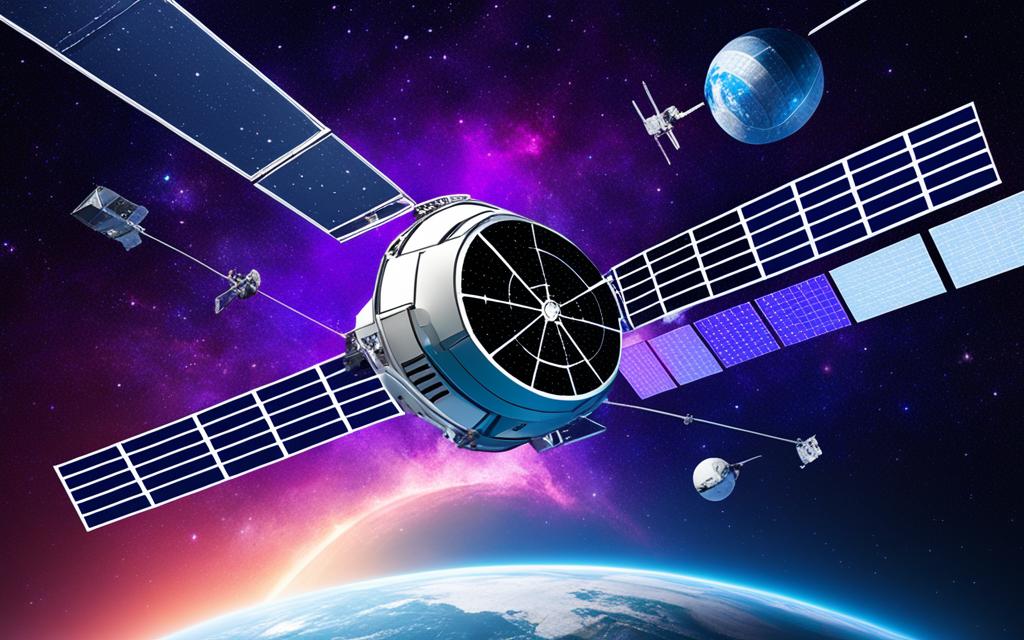
Understanding Quantum Communications
Quantum communications utilize quantum bits (qubits) and are based on two key features: Quantum Key Distribution (QKD) and quantum entanglement. QKD allows two parties to generate a shared secret key using the principles of quantum mechanics, providing theoretically unbreakable encryption. Quantum entanglement enables instant communication between particles, with the state of one particle affecting the state of another, even at large distances. These features make quantum communications highly secure and offer a new approach to information transmission.
Quantum Key Distribution (QKD) is a fundamental aspect of quantum communications. It enables secure key generation between two parties by exploiting the properties of quantum mechanics. Unlike traditional key exchange algorithms, QKD provides unconditional security, guarding against attacks by quantum computers. The shared secret key generated through QKD ensures secure communication channels and protects sensitive information.
Quantum entanglement, another key feature of quantum communications, allows for instantaneous communication between entangled particles. When particles are entangled, their quantum states become correlated, regardless of the distance between them. Any change in the state of one particle will simultaneously affect the state of the other, even if they are separated by vast distances. This phenomenon can be harnessed to create secure communication channels that are resistant to eavesdropping and tampering.
Quantum communications harness the power of quantum mechanics to establish highly secure communication channels through Quantum Key Distribution (QKD) and quantum entanglement.
The combination of QKD and quantum entanglement provides a foundation for quantum communications and enables secure and efficient information transmission. These features have significant implications for areas such as data security, cryptography, and secure communication networks.
To better understand quantum communications, it is beneficial to delve deeper into the concept of qubits. Qubits are the basic units of quantum information and represent the quantum states of particles. Unlike classical bits, which can only have values of 0 or 1, qubits can exist in a superposition of states, representing both 0 and 1 simultaneously. This property allows for the parallel processing of information and increases the computational power of quantum communication systems.
| Key Features of Quantum Communications | Benefits |
|---|---|
| Quantum Key Distribution (QKD) | – Provides unconditional security – Generates unbreakable encryption keys – Protects against attacks by quantum computers |
| Quantum Entanglement | – Enables instant communication between particles – Maintains correlation regardless of distance – Offers highly secure communication channels |
The unique properties of qubits, QKD, and quantum entanglement make quantum communication systems highly secure and resistant to unauthorized access. As technology continues to advance, quantum communications are poised to revolutionize data security and pave the way for a new era of secure information transmission.
Implementing Quantum Communication Infrastructure: A Roadmap
Implementing quantum communication infrastructure requires careful assessment, planning, research, collaboration, and infrastructure development. It is a multi-faceted process that involves various steps to ensure the successful integration of quantum technologies.
Firstly, a comprehensive assessment of the existing infrastructure needs to be conducted to determine its compatibility with quantum communication. This assessment helps identify potential gaps and areas that require improvement to support the implementation of quantum technologies.
Once the assessment is complete, the next step is to plan and strategize the implementation of quantum communication infrastructure. This includes defining the goals, objectives, and timelines for the project, as well as allocating the necessary resources and budget.
Research and collaboration play a crucial role in implementing quantum communication infrastructure. Engaging with academic institutions and industry experts allows for the exchange of knowledge, expertise, and best practices. Collaborative efforts facilitate the development of innovative solutions and drive advancements in the field.
Furthermore, infrastructure development is essential to support quantum communication. This involves deploying quantum repeaters, satellite-based quantum key distribution (QKD) systems, and other necessary equipment and facilities. The infrastructure needs to be designed and built to meet the specific requirements of quantum communication, ensuring secure and reliable transmission of quantum information.
To test the viability of the technology, pilot projects can be initiated. These projects serve as experimental platforms to evaluate the performance, scalability, and security of quantum communication infrastructure in real-world scenarios.
In addition to technical aspects, workforce development is crucial for the successful integration of quantum communication technology. Training programs and educational initiatives should be implemented to equip professionals with the necessary skills and knowledge to work with quantum technologies.
Public engagement is also vital to foster awareness and acceptance of quantum communication infrastructure. Communicating the benefits, applications, and importance of quantum communication to the general public helps build trust and support for the implementation of these advanced technologies.
By following a comprehensive roadmap that includes assessment and planning, research and collaboration, infrastructure development, pilot projects, and workforce development, the implementation of quantum communication infrastructure can be achieved effectively and securely.
| Steps | Action |
|---|---|
| Assessment | Conduct a thorough assessment of the existing infrastructure to identify compatibility and improvement opportunities. |
| Planning | Create a strategic plan, defining goals, objectives, timelines, and allocating resources for the implementation. |
| Research and Collaboration | Engage with academic institutions and industry experts to exchange knowledge, drive innovation, and develop collaborative solutions. |
| Infrastructure Development | Deploy quantum repeaters, satellite-based QKD systems, and other necessary equipment to support quantum communication. |
| Pilot Projects | Initiate pilot projects to test the performance, scalability, and security of quantum communication infrastructure. |
| Workforce Development | Implement training and educational programs to equip professionals with the necessary skills to work with quantum technologies. |
Conclusion
The integration of quantum communication into national infrastructures is essential for addressing modern security challenges. Countries like Greece, through initiatives like HellasQCI, are contributing to the advancement of quantum communication technology and securing their digital infrastructure. Quantum communication offers a more secure alternative to traditional encryption methods and has applications across various sectors, including government, finance, healthcare, and research and development. As nations continue to develop and implement quantum communication systems, we can expect a paradigm shift in international communication and security, ensuring a future of secure global communications.
FAQ
What is quantum communication?
Quantum communication is a revolutionary form of secure communication that utilizes the principles of quantum mechanics.
What role do quantum communication satellites play?
Quantum communication satellites play a crucial role in establishing secure space networks and protecting data transmission.
Why are quantum-secured communications important?
Quantum-secured communications provide unconditional security of critical data using quantum-resistant communication channels, mitigating the risk of data breaches.
What progress has been made in quantum-secured communications?
Significant progress has been made in demonstrating short-distance quantum-secured optical channels, with successful demonstrations of long-distance communication between Beijing and Vienna.
What is the QEYSSAT Project and Ciena’s role in it?
The QEYSSAT Project, owned by the Canadian Space Agency (CSA), aims to explore the viability of satellite quantum communication. Ciena is a key participant in the project, engaged in establishing quantum-secured optical channels between Quantum Ground Stations (QGS).
How do quantum communications work?
Quantum communications utilize quantum bits (qubits) and are based on Quantum Key Distribution (QKD) and quantum entanglement features.
How can quantum communication infrastructure be implemented?
Implementing quantum communication infrastructure requires assessing current infrastructure compatibility, conducting research, forming collaborations, and developing necessary physical infrastructure.

